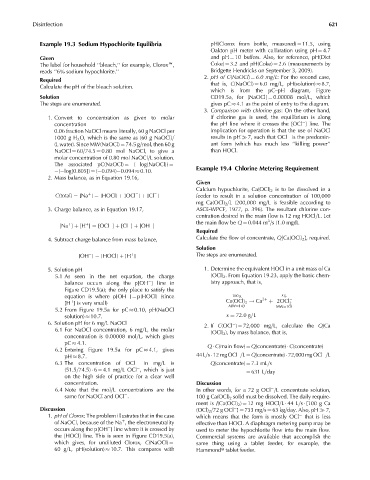Page 666 - Fundamentals of Water Treatment Unit Processes : Physical, Chemical, and Biological
P. 666
Disinfection 621
Example 19.3 Sodium Hypochlorite Equilibria pH(Clorox from bottle, measured) ¼ 11.5, using
Oakton pH meter with calibration using pH ¼ 4.7
Given and pH ¼ 10 buffers. Also, for reference, pH(Diet
The label for household ‘‘bleach,’’ for example, Cloroxe, Coke) ¼ 3.2 and pH(Coke) ¼ 2.6 (measurements by
reads ‘‘6% sodium hypochlorite.’’ Bridgette Hendricks on September 3, 2009).
2. pH of C(NaOCl) ¼ 6.0 mg=L: For the second case,
Required
that is, C(NaOCl) ¼ 6.0 mg=L, pH(solution) 8.7,
Calculate the pH of the bleach solution.
which is from the pC–pH diagram, Figure
Solution CD19.5a, for [NaOCl] ¼ 0.00008 mol=L, which
The steps are enumerated. gives pC 4.1 as the point of entry to the diagram.
3. Comparison with chlorine gas: On the other hand,
1. Convert to concentration as given to molar if chlorine gas is used, the equilibrium is along
concentration the pH line where it crosses the [OCl ] line. The
0.06 fraction NaOCl means literally, 60 g NaOCl per implication for operation is that the use of NaOCl
1000 g H 2 O, which is the same as (60 g NaOCl)= results in pH 7, such that OCl is the predomin-
(L water). Since MW(NaOCl) ¼ 74.5 g=mol, then 60 g ant form (which has much less ‘‘killing power’’
NaOCl ¼ 60=74.5 ¼ 0.80 mol NaOCl, to give a than HOCl.
molar concentration of 0.80 mol NaOCl=L solution.
The associated pC(NaOCl) ¼ ( log[NaOCl]) ¼ Example 19.4 Chlorine Metering Requirement
( log[0.805]) ¼ ( 0.094) 0.094 0.10.
2. Mass balance, as in Equation 19.16,
Given
Calcium hypochlorite, Ca(OCl) 2 is to be dissolved in a
C(total) ¼ [Na ] ¼ [HOCl] þ [OCl ] þ [Cl ] feeder to result in a solution concentration of 100,000
þ
mg Ca(OCl) 2 =L (200,000 mg=L is feasible according to
3. Charge balance, as in Equation 19.17, ASCE-WPCF, 1977, p. 396). The resultant chlorine con-
centration desired in the main flow is 12 mg HOCl=L. Let
3
the main flow be Q ¼ 0.044 m =s (1.0 mgd).
[Na ] þ [H ] ¼ [OCl ] þ [Cl ] þ [OH ]
þ
þ
Required
4. Subtract charge balance from mass balance, Calculate the flow of concentrate, Q[Ca(OCl) 2 ], required.
Solution
[OH ] ¼ [HOCl] þ [H ] The steps are enumerated.
þ
5. Solution pH 1. Determine the equivalent HOCl in a unit mass of Ca
5.1 As seen in the net equation, the charge (OCl) 2 . From Equation 19.23, apply the basic chem-
balance occurs along the p[OH ] line in istry approach, that is,
Figure CD19.5(a); the only place to satisfy the
equation is where p[OH ] ¼ p[HOCl] (since 100 g x g
[H ] is very small) Ca(OCl) 2 ! Ca 2þ þ 2OCl
2
þ
MW¼143 MW¼103
5.2 From Figure 19.5a for pC 0.10, pH(NaOCl
solution) 10.7. x ¼ 72:0g=L
6. Solution pH for 6 mg=L NaOCl 2. If C(OCl ) ¼ 72,000 mg=L, calculate the Q(Ca
6.1 For NaOCl concentration, 6 mg=L, the molar (OCl) 2 ), by mass balance, that is,
concentration is 0.00008 mol=L, which gives
pC 4.1.
6.2 Entering Figure 19.5a for pC 4.1, gives Q C(main flow) ¼ Q(concentrate) C(concentrate)
pH 8.7. 44 L=s 12 mg OCl =L ¼ Q(concentrate) 72,000 mg OCl =L
6.3 The concentration of OCl in mg=Lis Q(concentrate) ¼ 7.3 mL=s
(51.5=74.5) 6 ¼ 4.1 mg=L OCl , which is just
¼ 631 L=day
on the high side of practice for a clear well
concentration. Discussion
6.4 Note that the mol=L concentrations are the In other words, for a 72 g OCl =L concentrate solution,
same for NaOCl and OCl . 100 g Ca(OCl) 2 solid must be dissolved. The daily require-
ment is J(Ca(OCl) 2 ) ¼ 12 mg HOCl=L 44 L=s [100 g Ca
Discussion (OCl) 2 =72 g OCl ] ¼ 733 mg=s ¼ 63 kg=day. Also, pH 7,
1. pH of Clorox: The problem illustrates that in the case which means that the form is mostly OCl that is less
of NaOCl, because of the Na , the electroneutrality effective than HOCl. A diaphragm metering pump may be
þ
occurs along the p[OH ] line where it is crossed by used to meter the hypochlorite flow into the main flow.
the [HOCl] line. This is seen in Figure CD19.5(a), Commercial systems are available that accomplish the
same thing using a tablet feeder, for example, the
which gives, for undiluted Clorox, C(NaOCl) ¼
60 g=L, pH(solution) 10.7. This compares with Hammondt tablet feeder.

